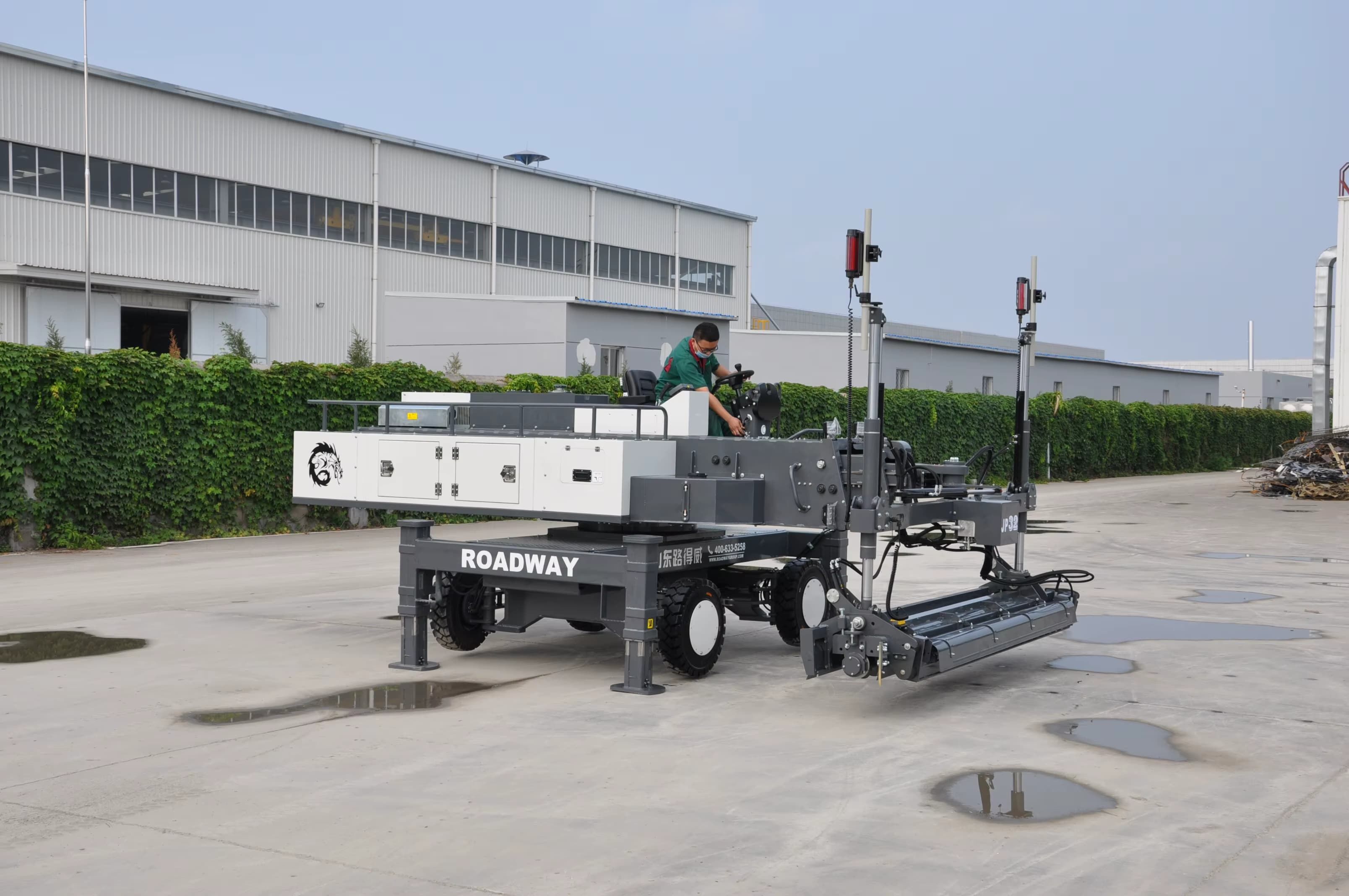Lazerli qotarma texnologiyasi qanday ishlaydi va nima uchun aniqlikni ta'minlaydi
Beton lazerli qotarma nima? Texnologiyani aniqlash
Beton ishlari uchun lazerli tégirmonlar asosan aylanuvchi pichqorlar va haqiqiy vaqtda o'lchov amalga oshiruvchi lazerlar yordamida sirtlarni tekislashni avtomatlashtirilgan tizimlardir. Qo'lda ishlash usullari asosan ishchilarning tajribasiga va hamma tomonidan yoqtirilmaydigan arqon chiziqlariga juda ham bog'liq bo'ladi. Yangi mashinalar GPS tizimlari bilan solishtiriladigan aniqlikni, shuningdek, obyektda sozlanishi mumkin bo'lgan gidravliklarni birlashtiradi. ASCE tomonidan 2023-yilda qurilish samaradorligi haqida o'tkazilgan so'nggi tadqiqotga ko'ra, ushbu lazerli tégirmon mashinalaridan foydalangan loyihalarda traditsion usullarga nisbatan tekislash vaqtining taxminan uchdan ikki qismi tejaldi. Shuningdek, yakuniy sirtlar bir xilroq bo'ldi, bu sifat eng muhim bo'lganda katta farq qiladi.

Lazer bilan boshqariladigan texnikaning asosiy komponentlari
| Komponent | Funktsiya |
|---|---|
| Lazerli uzatgich | Plitani balandligi uchun etalon sifatida aylanuvchi lazer tekisligini loyihalaydi |
| Tayanchga o'rnatilgan sensor | ±1 mm (0,04 dyuym) gacha bo'lgan lazer balandligidagi og'ishlarni aniqlaydi |
| Hidrolik boshqaruvi tizimi | Sensor signallariga asosan pichqorning balandligi va burchagini avtomatik ravishda sozlaydi |
| Energiya biryoni | Blad aylanishini (odatda 40–75 RPM) va uskuna harakatini boshqaradi |
Yetakchi ishlab chiqaruvchilar ushbu komponentlarni kunduzi 12–16 soat yuqori changli muhitda ishlashga chidamli, modulli qismlarga ega bo'lib, tezkor maydonda ta'mirlash imkonini beradigan qilib loyihalashtiradilar.
Lazerli tekislash betonni aniq va tekis darajaga keltirishni qanday ta'minlaydi
Beton quyilayotganda, barcha narsa ish maydoni ustidan tekislik hosil qiluvchi lazer tarangotchidan boshlanadi. Aralashma tushayotganida, skreyd tirgaklariga o'rnatilgan sensorlar balandlikdagi o'zgarishlarni aniqlab, natijada g'idg'ili mexanizm poydevor taxtasini deyarli darhol sozlaydi. Bu tizimni shunchalik yaxshi qiladigan jihat shundaki, u FF 50/FL 40 atrofidagi qattiq tekislilik me'yorida yoki undan ham yaxshiroq natija beradi va eski usullarda kuzatiladigan qayta ishlash hajmini taxminan uchdan biriga kamaytiradi. Ba'zi yangi avlod mashinalar 15% gacha bo'lgan egriklarni ham boshqara oladi va millimetr darajasidagi aniqlikni saqlab turadi. Katta binolar, masalan, omborxona va zavodlarda to'planish xavf-xatarini kamaytirish uchun bunday aniqlik ayniqsa muhim.
Lazerli skreydlarning turlari: Orqasidan ketiladigan, O'tiriladigan va Strelali modellar taqqoslanmoqda
Orqasidan ketiladigan, O'tiriladigan va Strelali Lazerli Skreydlar: Asosiy farqlar va qo'llanilish sohalari
Yaqin burchaklar va to'siqlar atrofida oson harakatlanish imkoniyati tufayli, taxminan 12 000 kvadrat futgacha bo'lgan maydonlarni qoplanish uchun orqasida ketadigan lazerli reykalardan foydalanish eng yaxshisidir. Ular eski do'konlar polini ta'mirlash yoki uy uchun yangi beton quyish kabi ishlarda ajoyib natija beradi. Biroq, 12 mingdan 50 ming kvadrat futchacha bo'lgan katta maydonlarda esa, ustida turib boshqariladigan modellar aniq ustunlik qiladi. Masalan, omborxona polini qolishda, xodimlar hamma joyga piyoda borish o'rniga soatiga ancha kengroq hududdan o'tishlari mumkin. Ba'zi hisobotlarga ko'ra, operatorlar bunday uskunalar bilan ishlaganda 35 dan hatto 50 foizgacha ko'proq maydonga ega bo'lishlari hamda tugallashlari hamda imkoniyat mavjud. Va nihoyat, 50 ming kvadrat futdan ortiq bo'lgan katta sanoat binolarida ishlatiladigan kuchli jihozlar ham bor. Bu vaziyatlarda ulkan 65 futgacha bo'lgan uzunlikdagi tirlar bilan jihozlangan boomli tizimlar hukmronlik qiladi, shu tufayli ishchilar beton quyish jarayonida uskunalarni doim to'xtatib, oldinga-ortinga ko'chirish zarurati tug'ilmasdi.
Plitalarning qalinligi, o'lchami va loyiha murakkabligiga moslashuvchanlik
Zamonaviy lazerli qotlar 4" dan 18" gacha bo'lgan plitalarni qo'llaydi. Orqasidan yurib boshqariladigan modellar 4–8" to'ldirishlarda a'lo bajariladi, bo'linma tizimlari esa og'ir 12–18" asoslari uchun mo'ljallangan. O'tirish uchun mo'ljallangan variantlar avtomatlashtirilgan tarqatish markazlarida talab qilinadigan ±1/8" tekislilik me'yorida 10% gacha bo'lgan qiyaliklarga moslashish orqali muvozanatni saqlaydi.
Barcha modellar bo'ylab foydalanuvchiga qulay boshqaruv va ishlatish osonligi
Barcha zamonaviy lazerli qotlarda haqiqiy vaqtda darajani nazorat qilish imkonini beradigan intuitiv sensorli ekran interfeyslari mavjud. Orqasidan yurib boshqariladigan uskunalar yengil ko'chiriluvchanlikka (300 funtdan kam) e'tibor qaratadi, o'tirish uchun mo'ljallangan modellarda sozlanadigan o'rindiqlar hamda 360° ko'rish doirasi mavjud. Bo'linma tizimlari avtomatlashtirilgan marshrut rejalashtirish dasturini o'z ichiga oladi, bu esa operatorlarni o'qitish muddatini qo'lda sozlashga qaraganda 40% qisqartiradi.
Yetakchi ishlab chiqaruvchilarning innovatsion xususiyatlari
So'nggi modellarda betonning konsistentsiyasi o'zgarganda ham ishlatish jarayonida kompensatsiya qiluvchi sun'iy intellektli o'tkazma sozlanishi qo'llaniladi. Ba'zilari yer osti avtoturargohlaridagi kabi GPS signallaridan mahrum muhitda ham millimetr darajadagi aniqlikni saqlash uchun ikki chastotali GPS-dan foydalanadi. Modulli dizayn asosiy komponentlarni osongina yangilash imkonini beradi va texnologiyalarning rivojlanishiga moslashish uchun to'liq almashtirish talab qilinmaydi.
Yetakchi ishlab chiqaruvchilarning innovatsion xususiyatlari
Lazerli tarash texnologiyasi omborxonalarda, zavodlarda va stadionlarda kabi barqarorlik ayniqsa muhim bo'lgan joylarda pol qanday qurilayotganini o'zgartirmoqda. Bu sifatli yakuniy sirt sifatini qo'ldan boy berishsiz jarayonni tezlashtiradi.
Katta, og'ir maydonlarda yuqori tekislilik va yaxshi yakuniy sifatni ta'minlash
Zamonaviy lazerli tarash uskunalari katta, og'ir maydonlarda yuqori tekislilik va yaxshi yakuniy sifatni ta'minlashga mo'ljallangan bo'lib, pol tekisliligi va gorizontal darajasiga oid sanoat standartlariga javob beradi. Ular omborxona va zavodlar kabi keng hududlarda suv saralishini ta'minlashga yordam beradi.
Yetakchi ishlab chiqaruvchilarning innovatsion xususiyatlari
Hozirgi ilg'or modellar betonning konsistensiyasini o'rnatish paytida kompensatsiya qiluvchi sun'iy intellektga ega bo'lgan so'rish tizimini o'z ichiga oladi. Bu kelajakda ta'mirlash talablari va bog'liq xarajatlarni kamaytirish uchun yakuniy mahsulot mustahkam hamda barqaror bo'lishini ta'minlaydi.
Savollar boʻlimi
Lazerli greder nima?
Lazerli greder — yuza tekisliligini ta'minlash va aniq darajada tekislash uchun lazerlar hamda aylanuvchi pichqorlardan foydalangan holda ishlaydigan ilg'or beton tekislash uskunasidir, bu esa an'anaviy usullarga nisbatan aniqlik hamda samaradorlik jihatidan ustun turadi.
Qanday turlari mavjud lazerli grederlar?
Asosan uchta turi mavjud: kichik maydonlarda foydalanish uchun orqasidan ketiladigan modellar, o'rtacha hajmdagi loyihalarda foydalaniladigan o'tiriladigan modellar hamda katta sanoat binolarida foydalaniladigan boom (strelali) modellar.
Sanoat polini qurishda nima uchun lazerli gredderlar afzallikka ega?
Lazerli gredderlar yuqori chidamlilik, yaxshilangan tekislilik standartlari hamda tezroq qurilish muddatlarini ta'minlaydi. Ular ayniqsa, aniq tekislash va suvni oqazish talab etiladigan keng, egri maydonlarda samarali ishlaydi.
An'anaviy beton usullar afzal bo'lgan vaziyatlar bormi?
Kichikroq, tor joylarda yoki devorlar va chetlar yaqinidagi hududlarda lazerli qotirma uskunalarining bunday sharoitlarda harakatlana olish cheklovlari tufayli an'naviy usullar afzal ko'rilishi mumkin.
Mundarija
- Lazerli qotarma texnologiyasi qanday ishlaydi va nima uchun aniqlikni ta'minlaydi
-
Lazerli skreydlarning turlari: Orqasidan ketiladigan, O'tiriladigan va Strelali modellar taqqoslanmoqda
- Orqasidan ketiladigan, O'tiriladigan va Strelali Lazerli Skreydlar: Asosiy farqlar va qo'llanilish sohalari
- Plitalarning qalinligi, o'lchami va loyiha murakkabligiga moslashuvchanlik
- Barcha modellar bo'ylab foydalanuvchiga qulay boshqaruv va ishlatish osonligi
- Yetakchi ishlab chiqaruvchilarning innovatsion xususiyatlari
- Yetakchi ishlab chiqaruvchilarning innovatsion xususiyatlari
- Savollar boʻlimi

